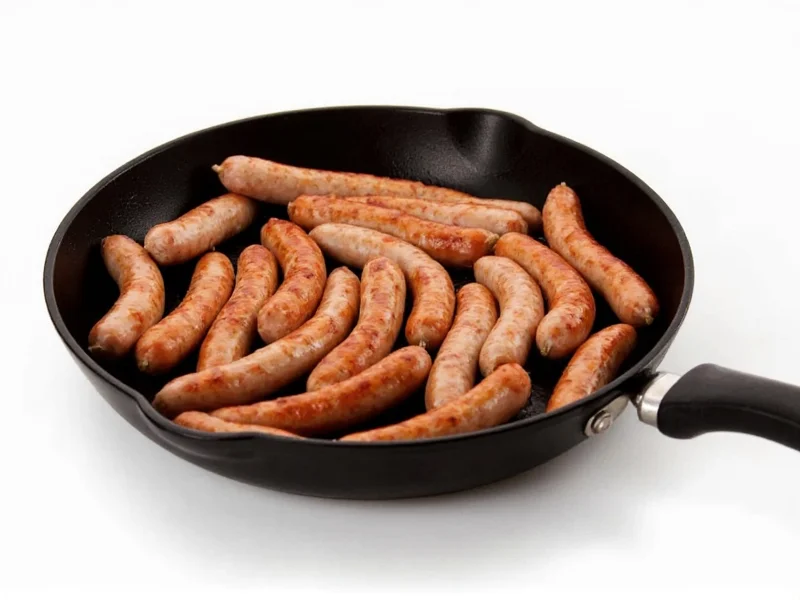To cook sausage in a pan, heat 1-2 tablespoons of oil over medium heat, prick sausages lightly with a fork, add to the pan, and cook for 15-20 minutes, turning frequently until golden brown and internal temperature reaches 160°F (71°C) for pork or 165°F (74°C) for poultry sausages. Never pierce too deeply as this releases juices, and always use a meat thermometer for food safety.
Cooking sausage in a pan is one of the most accessible and reliable methods for preparing this versatile protein. Whether you're working with Italian sausage, bratwurst, chorizo, or breakfast links, the stovetop offers precise temperature control that ensures perfectly cooked results every time. This comprehensive guide covers everything you need to know about the best way to cook sausage in a skillet, including professional techniques that prevent common mistakes like bursting casings or uneven cooking.
Essential Equipment for Pan-Cooking Sausage
Before you start cooking, gather these kitchen essentials:
- Heavy-bottomed skillet or frying pan (cast iron or stainless steel works best)
- Metal spatula or tongs for turning
- Meat thermometer (critical for food safety)
- Small fork for light pricking
- Paper towels for draining excess grease
Selecting the Right Sausage for Pan Cooking
Not all sausages respond equally well to pan cooking. Fresh sausages like Italian, bratwurst, and breakfast links work best for this method. Pre-cooked sausages require less cooking time but still benefit from pan-searing for texture. Avoid frozen sausages unless fully thawed, as they'll release too much moisture during cooking.
Step-by-Step Guide: How to Cook Sausage in a Pan
- Prepare your workspace: Remove sausages from packaging and pat dry with paper towels. Moisture is the enemy of proper browning.
- Prick carefully: Using a fork, make 3-4 shallow pricks on each sausage. This prevents bursting but doesn't compromise juiciness.
- Heat the pan: Place your skillet over medium heat and add 1-2 tablespoons of high-smoke point oil (avocado, canola, or vegetable oil).
- Add sausages: Once the oil shimmers (about 2 minutes), arrange sausages in a single layer with space between them.
- Cook patiently: Allow sausages to cook undisturbed for 4-5 minutes until a golden crust forms.
- Rotate regularly: Turn sausages every 3-4 minutes using tongs for even cooking on all sides.
- Monitor temperature: After 12 minutes, begin checking internal temperature in the thickest part.
- Rest before serving: Transfer cooked sausages to a plate, tent with foil, and rest for 5 minutes.
Perfect Pan-Fried Sausage Technique: Professional Tips
Mastering how to prevent sausage from burning in pan requires understanding heat management. Many home cooks make the mistake of using too high heat, which causes the exterior to burn before the interior cooks through. The ideal temperature range is 325-350°F (163-177°C). If you notice excessive smoking, reduce the heat immediately.
For thicker sausages like bratwurst, consider this professional technique: after initial browning, add ¼ cup of liquid (water, beer, or broth) to the pan, cover, and let steam for 5-7 minutes before finishing with uncovered cooking. This ensures thorough cooking without drying out the meat.
| Sausage Type | Total Cooking Time | Target Internal Temp | Special Considerations |
|---|---|---|---|
| Breakfast Links (pork) | 12-15 minutes | 160°F (71°C) | Cook over medium-low heat |
| Italian Sausage | 18-22 minutes | 160°F (71°C) | Prick lightly before cooking |
| Bratwurst | 20-25 minutes | 160°F (71°C) | Consider par-cooking in liquid |
| Chicken Sausage | 15-18 minutes | 165°F (74°C) | Use medium heat to prevent drying |
| Chorizo (fresh) | 15-20 minutes | 160°F (71°C) | Expect significant grease release |
Common Mistakes When Cooking Sausage in a Pan
Understanding how long to cook sausages on stove prevents these frequent errors:
- Overcrowding the pan: Causes steaming instead of browning
- Turning too frequently: Prevents proper crust formation
- Using the wrong oil: Olive oil burns at sausage-cooking temperatures
- Skipping the thermometer: Visual cues alone aren't reliable for food safety
- Not resting after cooking: Causes juices to spill out when cut
Food Safety Considerations for Pan-Cooked Sausage
When learning how to safely cook raw sausage in pan, remember these critical food safety points:
- Never partially cook sausage and refrigerate for later completion
- Keep raw sausage separate from other ingredients to prevent cross-contamination
- Clean all surfaces and utensils that contact raw sausage with hot, soapy water
- Consume cooked sausage within 2 hours or refrigerate promptly
- Reheat leftovers to 165°F (74°C) before serving
Serving Suggestions for Perfect Pan-Cooked Sausage
The best way to cook sausage in a skillet preserves both flavor and texture, making it versatile for numerous dishes. Serve Italian sausage with peppers and onions for a classic sandwich, pair bratwurst with sauerkraut and mustard, or slice cooked breakfast sausage to top hearty breakfast hashes. The flavorful pan drippings can be used to cook vegetables or create a simple pan sauce by deglazing with a splash of wine or broth.
Storage and Reheating Tips
Properly cooked sausage can be refrigerated for 3-4 days or frozen for up to 3 months. When reheating, place in a lightly oiled skillet over medium-low heat until heated through. Avoid microwaving, which can make casings tough and rubbery. For meal prep enthusiasts, pre-cooking sausage using the perfect pan-fried sausage technique ensures quick assembly for future meals.











 浙公网安备
33010002000092号
浙公网安备
33010002000092号 浙B2-20120091-4
浙B2-20120091-4